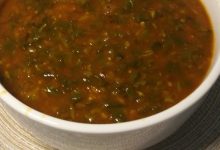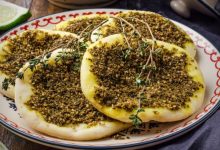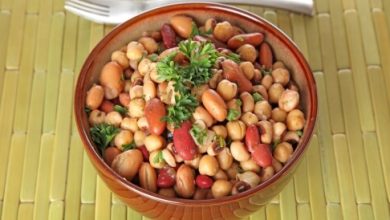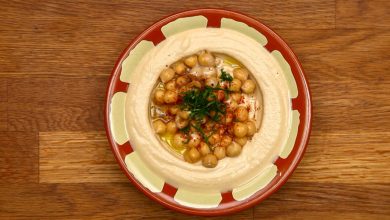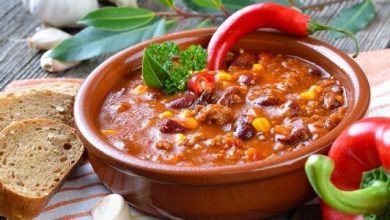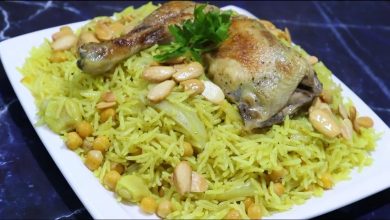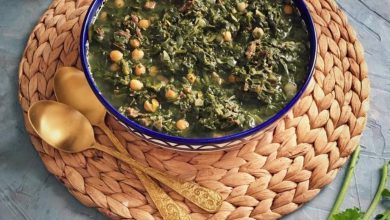Introduction
At Love With Recipes, we believe that exploring traditional dishes from diverse culinary traditions enriches our understanding of global flavors. One such remarkable dish is Foul bil Laban, a hearty and nourishing Arabic delicacy that combines the earthy richness of green fava beans with the creamy tang of fermented milk, known as Jameed. This dish exemplifies the culinary ingenuity of Middle Eastern cuisine, blending robust flavors with comforting textures to create a meal that is both satisfying and culturally significant.
Foul bil Laban is not merely a dish; it is a cultural experience that has been passed down through generations, often prepared during winter months when fresh green fava beans are available. The harmonious combination of tender beef, aromatic spices, and the unique flavor of Jameed makes it a treasured recipe that embodies tradition, flavor, and nutritional richness. Whether served as a main course during festive gatherings or a comforting family meal, this dish offers a taste of authentic Middle Eastern hospitality and culinary artistry.
Time
Preparing Foul bil Laban from start to finish requires approximately 2.5 to 3 hours, depending on the method of cooking and the tenderness of the meat. The process involves soaking, chopping, boiling, and simmering, each step contributing to the development of deep flavors and perfect textures. For those using a pressure cooker, the cooking time can be reduced significantly, making it more suitable for busy weeknights. The most time-consuming phase is the simmering of the beef and beans to achieve ideal tenderness and flavor infusion.
Needed Equipment
- Large stockpot or heavy-bottomed saucepan
- Pressure cooker (optional but recommended for faster cooking)
- Fine chopping knife
- Cutting board
- Measuring spoons and cups
- Strainer or colander for washing beans
- Mixing spoon or ladle
- Blender or food processor (for preparing the Jameed)
- Small saucepan for soaking and dissolving Jameed
- Serving bowls or deep plates
- Kitchen thermometer (optional for checking water temperature)
- Peeler (if needed for preparing onions or other vegetables)
Tags
Middle Eastern, Traditional, Comfort Food, Winter Recipes, Hearty, Nourishing, Family Meal, Authentic, Cultural Cuisine, Slow-Cooked, Spicy, Dairy-Free Alternative, Protein-Rich
Serving Size
This recipe yields approximately 4 to 6 servings, depending on portion size and accompaniments. It is ideal for a family meal or small gathering. For larger groups, ingredients can be scaled proportionally, maintaining the same cooking times and methods.
Difficulty Level
Intermediate. The preparation involves multiple steps, including soaking, chopping, boiling, and simmering, with attention to seasoning and texture. Basic knowledge of stovetop and pressure cooker usage is recommended. However, with patience and careful execution, even novice cooks can master this dish.
Allergen Information
- Dairy: Contains fermented milk (Jameed)
- Meat: Beef (or other preferred meats)
- Spices: Includes pepper, turmeric, and aromatic herbs
For those with dairy allergies or lactose intolerance, the Jameed can be replaced with a suitable dairy-free alternative, such as fermented soy or coconut-based products, though this may alter the authentic flavor profile.
Dietary Preference
Traditional version is non-vegetarian and dairy-based. For vegetarian or vegan adaptations, omit the meat and use plant-based protein sources, and replace Jameed with a dairy-free fermented alternative. The dish is naturally gluten-free if prepared without additives.
Course
Main Course
Cuisine
Middle Eastern / Levantine
Ingredients
| Ingredient | Quantity | Notes |
|---|---|---|
| Green Fava Beans (Foul Ahmar) | 500 grams (about 1.1 lbs) | Fresh or frozen |
| Beef (or preferred meat) | 500 grams (about 1.1 lbs) | Cut into large chunks |
| Jameed (Dried Fermented Milk) | 1 piece (about 100 grams) | Can substitute with fermented dairy or dairy-free alternative |
| Onion | 2 large | One for boiling, one for sautéing |
| Turmeric powder | 0.25 teaspoon | |
| White pepper | 0.5 teaspoon | |
| Salt | to taste | |
| Vegetable oil | 3 tablespoons | |
| Cardamom pods (green) | 3 | |
| Cloves | 1 stick | |
| Bay leaves | 3 |
Instructions
Preparation of Jameed (Dried Fermented Milk)
The process begins with preparing the Jameed, which provides the dish’s characteristic tangy flavor. If you have pre-made Jameed, proceed to soaking. Otherwise, prepare fresh by soaking a piece of dried fermented milk in two cups of cold water for at least 4 hours or overnight. After soaking, blend thoroughly in a blender or food processor until smooth, adding a little water if necessary. Pass the mixture through a fine sieve to remove any lumps. Set aside for later use.
Preparing the Meat
Begin by cutting the beef into large chunks, approximately 2-3 inches in size. Rinse the pieces thoroughly in cold water to remove any residual blood or impurities. Place the meat in a large stockpot or pressure cooker, then add enough cold water to cover the meat completely—about 4-5 cups. Bring to a boil over medium-high heat, skimming off any foam or scum that rises to the surface with a slotted spoon. This step is crucial for a clean broth and optimal flavor.
Once the foam is removed, add the whole onion cut into quarters, the green cardamom pods, cloves, and bay leaves for aromatic infusion. Reduce the heat to low or, if using a pressure cooker, lock the lid and cook under high pressure for approximately 30-40 minutes. If cooking without a pressure cooker, simmer gently for 1.5 to 2 hours until the meat becomes tender and easily pulls apart with a fork. Check periodically to ensure there’s enough water, adding more hot water as needed to prevent burning or sticking.
Preparing the Fava Beans
While the meat is cooking, rinse the fresh or frozen green fava beans carefully in cold water. Remove any stems, strings, or damaged beans. Cut the beans into small pieces, approximately 1-1.5 inches, to facilitate even cooking and better integration into the dish. Removing the outer stems and strings enhances the texture and reduces fibrousness, making the dish smoother and more palatable.
Sautéing the Onions and Fava Beans
In a separate pan, heat the vegetable oil over medium heat. Finely chop the second onion into small, uniform pieces. Add the chopped onion to the hot oil and sauté until translucent and fragrant, approximately 5-7 minutes. This step develops the base flavor and adds sweetness to the dish.
Once the onions are fragrant, add the chopped fava beans along with a pinch of salt, white pepper, and turmeric. Stir well to coat the beans with the spices and cook for about 10-15 minutes, allowing them to soften and absorb the flavors. Keep stirring occasionally to prevent sticking and ensure even cooking.
Preparing the Jameed Mixture
While the beans are cooking, prepare the Jameed solution. Take the soaked and blended Jameed, and warm it gently in a small saucepan over low heat. Stir continuously to prevent burning or curdling. The goal is to create a smooth, pourable mixture that can be easily incorporated into the broth.
Combining Ingredients and Final Cooking
Once the meat is tender, remove the whole onion, cardamom pods, cloves, and bay leaves from the broth. You can strain the broth if desired for clarity, but keeping the spices may enhance the flavor further. Add the cooked beef chunks along with the broth into the pan with sautéed onions and fava beans.
Gradually pour in the warmed Jameed mixture, stirring continuously to prevent curdling. Adjust the seasoning with salt and white pepper as needed. Bring the entire mixture to a gentle simmer over low heat, allowing the flavors to meld for at least 20-30 minutes. During this time, the dish thickens slightly, and the flavors deepen, creating a harmonious blend of savory, tangy, and spiced notes.
Preparation Tips
- For a richer flavor, roast the beef slightly before adding it to the broth, or sear the chunks in a hot skillet until browned.
- The quality of Jameed significantly impacts the final taste. Use fresh or properly stored Jameed for authentic flavor.
- If you prefer a thicker consistency, allow the dish to simmer longer or mash some of the beans gently into the broth.
- Adjust spice levels according to personal preference, adding more pepper or turmeric if desired.
Nutritional Information
| Nutrient | Per Serving (approximate) |
|---|---|
| Calories | ~450 kcal |
| Protein | ~35 grams |
| Fat | ~15 grams |
| Carbohydrates | ~40 grams |
| Fiber | ~10 grams |
| Sugar | ~5 grams |
Tips and Tricks
- Pre-soaking the Jameed makes it easier to incorporate into the dish, reducing lumps and curdling.
- Using fresh spices enhances aroma; consider crushing whole spices just before adding for maximum flavor.
- If the dish thickens too much during simmering, dilute it with a little hot water or broth to achieve desired consistency.
- For a more intense flavor, add a squeeze of fresh lemon juice just before serving.
Add-ons
- Chopped fresh parsley or cilantro for garnish
- Crushed walnuts or pine nuts for added texture
- Fresh lemon wedges for a tangy finish
- Hot chili flakes for spice lovers
Side Dishes
- Steamed white rice or saffron rice
- Flatbread or pita bread
- Pickled vegetables or salads
- Yogurt or laban for cooling
Improvements
- Experiment with different types of meat such as lamb or goat for varied flavor profiles.
- Incorporate additional vegetables such as carrots or potatoes for added nutrition and texture.
- Use a slow cooker for convenience, allowing the flavors to develop gradually over several hours.
- Add a touch of tomato paste for a richer color and depth of flavor.
Save and Store
This dish is best enjoyed fresh but can be stored in an airtight container in the refrigerator for up to 2 days. To reheat, gently warm over low heat, stirring occasionally. If the dish thickens upon standing, add a splash of hot water or broth to restore its consistency. For longer storage, freezing in portions is possible, but note that the texture may change slightly upon thawing, especially if dairy components are involved.
FAQ
Can I substitute Jameed with other dairy products?
Yes. If Jameed is unavailable, you can replace it with thick, fermented dairy such as Greek yogurt or buttermilk. To mimic the tangy flavor, blend yogurt with a small amount of lemon juice or vinegar. For a more authentic taste, however, Jameed remains preferred.
Can I make this dish vegetarian?
Absolutely. Omit the meat and increase the quantity of fava beans or add other vegetables like carrots, potatoes, or squash. Use a plant-based protein, such as lentils or chickpeas, for added richness. Replace dairy with coconut or soy-based fermented products for the tangy element.
Is this dish spicy?
The traditional recipe is mildly spiced, primarily flavored with aromatic spices and pepper. Adjust seasoning to your preference, adding chili flakes or hot sauce for extra heat.
How can I reduce the cooking time?
Using a pressure cooker significantly shortens cooking time, especially for tender meat and well-softened beans. Pre-soaking the beans and meat also helps speed up the process.
Conclusion
Foul bil Laban stands as a testament to Middle Eastern culinary heritage, offering a unique blend of flavors that celebrate both tradition and comfort. Its preparation, while involving several steps, results in a richly flavored, nourishing dish that embodies the warmth and hospitality of the region. At Love With Recipes, we encourage you to explore this authentic recipe, adapt it to your taste preferences, and share it with loved ones to enjoy the true essence of Middle Eastern cuisine. Whether served during winter nights or special gatherings, this dish promises to delight your palate and deepen your appreciation for cultural culinary artistry.
References
- “Traditional Middle Eastern Cuisine,” by Dr. Samir Al-Ali, 2019.
- “The Art of Middle Eastern Cooking,” by Laila El-Haddad, 2021.


